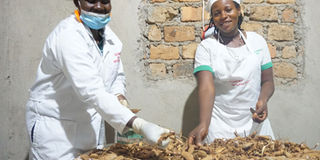Ejang cashes in on tamarind

Lillian Ejang (L) who has carved a niche in value addition by processing tamarind fruits. Photo by Phionah Nassanga
What you need to know:
- Tamarind, known as enkooge in some dialects in Uganda and prized for its sweet-and-sour taste, is rich in vitamins, minerals and antioxidants. Often used to make juice, its sticky pulp is also a rich source of dietary fibre. Lillian Ejang believes that value addition to this wonder tree and its fruits would be of great help in upscaling ways of combating malnutrition in the country, writes Phionah Nassanga.
Seeing vendors selling them by the road side around Nakasero market, one would wonder what they are. Enkooge (tamarinds) is a fruit that will not easily attract buyers unless you are well conversant with them. Tamarinds are pod-like fruits with a brown covering that contains edible fleshy tissue. Unlike other farmers, as a way of increasing her earnings, Lillian Ejang, 37, decided to add value to tamarind.
After four years of imprisonment, Ejang had lost everything. She decided to embrace tamarind farming. “Growing up with my grandparents in Kigumba, Kiryandongo District, we had lots of tamarind trees and each time people came complaining of different illnesses, my grandparents would either recommend them to eat tamarind or make juice out of it,” she explains. Thinking of tamarinds’ sweet-sour taste, Ejang knew not many people would enjoy the fruit so to attract more buyers, she decided to make juice out of them.
Getting started
Creating employment for herself, she started the search for tamarind. For two months in Kigumba, Ejang moved to different homes asking farmers if they would sell to her their tamarind.
“For the start, many were giving her the tamarind pods for free. In many homesteads the pods were just rotting away, yet others wanted to cut the trees for charcoal,” she explains.
Ejang also moved to Nakasongola, Apac, and Kiryandongo buying tamarind and sensitising people not to cut down their trees. She buys each tamarind tree at Shs500,000 for every harvest.
“I also give a token of appreciation to farmers who have not cut down their trees. By so doing, this helps me entice the tree owners thus increasing my harvest for every season,” she says.
However, Ejang says tamarinds are slow-growing trees taking about 10 years. When they mature and bear fruits, these can be left on the tree for as long as six months. She says tamarinds are harvested by pulling the pods away from the stalk.
Process
Collect ripe tamarind pods from the trees and then sun-dry the pods to help you break the brown cover easily.
Once the cover is broken, you can peel them off to get a smooth paste flesh clinging tight to the hardened dark-brown seeds with fibres.
Use a weighing scale to help you know how many kilogrammes of tamarind you need. Knowing the right amounts will help you determine the amount of water needed.
Soak them in boiling water to detach the seeds from the flesh. She says when boiling, you will need a thermometer to help you confirm the water has reached boiling point – 100 degrees.
After the seeds have separated from the seeds, the water will turn into a thick dark brown solution.
For a nice aroma and taste, she adds other ingredients such as ginger and cinnamon. Then use a sieve to drain the boiled content in another bowl leaving it to cool.
“The juice is sugar free so for those who consume sugar, you can always add to sweeten,” she says.
Tamarind paste
From the waste particles after sieving, Ejang makes tamarind paste.
She makes it by boiling the tamarind waste, stirring it continuously as it boils to form a thick paste that is completely mushy. To the paste she adds a little garlic and filters.
Tamarind tea
From the tamarind seeds, Ejang makes tamarind tea. She roasts the dry tamarind seeds until they form a sweet-smelling aroma and turn dark brown. Letting the seeds cool, she then peels off the seed coats using her fingers. Pounding the seeds using a mortar and pestle, she carefully crushes them to form tamarind tea powder.




